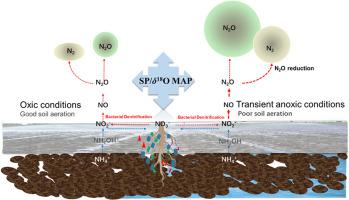当前位置:
X-MOL 学术
›
Soil Biol. Biochem.
›
论文详情
Our official English website, www.x-mol.net, welcomes your feedback! (Note: you will need to create a separate account there.)
Transient anoxic conditions boost N2O emissions by stimulating denitrification capacity and decreasing N2O reduction ratio in soils with different carbon substrates
Soil Biology and Biochemistry ( IF 9.7 ) Pub Date : 2024-02-04 , DOI: 10.1016/j.soilbio.2024.109351 Shan Zhuang , Junjun Ding , Wei Lin , Qian Zheng , Xinyue Kou , Qiaozhen Li , Chunying Xu , Lili Mao , Yanshuo Pan , Ying Gao , Dongfei Han , Yuzhong Li
Soil Biology and Biochemistry ( IF 9.7 ) Pub Date : 2024-02-04 , DOI: 10.1016/j.soilbio.2024.109351 Shan Zhuang , Junjun Ding , Wei Lin , Qian Zheng , Xinyue Kou , Qiaozhen Li , Chunying Xu , Lili Mao , Yanshuo Pan , Ying Gao , Dongfei Han , Yuzhong Li

|
Quantitative identification of the dominant NO production and consumption processes following sudden shifts in soil aeration in well-aerated soils is limited, lagging the development of NO mitigation strategies. Nitrous oxide emissions from agricultural soils, the largest source of anthropogenic NO, are strongly influenced by low-molecular-weight organic carbons from root exudates (RootEx). In this study, we conducted a laboratory incubation experiment to investigate the mechanisms of NO emissions regulated by transient anoxic conditions under the effects of different carbon substrates. Three common components in RootEx, oxalic acid, serine, and glucose were individually added as carbon sources every 24 h to the sandy loam soil. The contribution of microbial processes to NO production (fungal denitrification, nitrification, bacterial denitrification) and consumption (NO reduction) was evaluated using a dual isotope mapping approach (SP/O MAP). The result indicated that transient anoxic conditions stimulated NO production primarily through bacterial denitrification process facilitated by carbon substrates, and diminished the proportion of NO reduction compared to oxic conditions. Among the three components of RootEx, serine and glucose induced higher NO emissions and NO reduction rates than oxalic acid during incubation. The differential effects of these three components on NO emissions imply that the regulatory effect of carbon substrates on NO reduction could not counterbalance the influence of transient anoxic conditions on NO stimulation. Our findings provide a fundamental understanding of the effects of transient anoxic conditions and RootEx on NO stimulation, facilitating the study of the spatial and temporal heterogeneity of NO emissions in response to soil aeration changes in various upland soils.
中文翻译:

瞬时缺氧条件通过刺激不同碳底物土壤的反硝化能力和降低 N2O 还原率来增加 N2O 排放
在通气良好的土壤中,土壤通气突然变化后,对主要的 NO 产生和消耗过程的定量识别是有限的,滞后于 NO 减排策略的发展。农业土壤中的一氧化二氮排放是人为一氧化氮的最大来源,受到根系分泌物 (RootEx) 中低分子量有机碳的强烈影响。在本研究中,我们进行了实验室孵化实验,以研究不同碳底物作用下瞬时缺氧条件调节NO排放的机制。每 24 小时将 RootEx 中的三种常见成分草酸、丝氨酸和葡萄糖作为碳源分别添加到沙壤土中。使用双同位素图谱方法 (SP/O MAP) 评估微生物过程对 NO 产生(真菌反硝化、硝化、细菌反硝化)和消耗(NO 还原)的贡献。结果表明,瞬时缺氧条件主要通过碳底物促进的细菌反硝化过程刺激NO产生,并且与好氧条件相比减少了NO还原的比例。在 RootEx 的三种成分中,丝氨酸和葡萄糖在培养过程中比草酸诱导更高的 NO 排放和 NO 还原率。这三种成分对 NO 排放的不同影响意味着碳底物对 NO 还原的调节作用不能抵消瞬时缺氧条件对 NO 刺激的影响。我们的研究结果提供了对瞬态缺氧条件和 RootEx 对 NO 刺激的影响的基本了解,有助于研究 NO 排放响应各种高地土壤通气变化的空间和时间异质性。
更新日期:2024-02-04
中文翻译:

瞬时缺氧条件通过刺激不同碳底物土壤的反硝化能力和降低 N2O 还原率来增加 N2O 排放
在通气良好的土壤中,土壤通气突然变化后,对主要的 NO 产生和消耗过程的定量识别是有限的,滞后于 NO 减排策略的发展。农业土壤中的一氧化二氮排放是人为一氧化氮的最大来源,受到根系分泌物 (RootEx) 中低分子量有机碳的强烈影响。在本研究中,我们进行了实验室孵化实验,以研究不同碳底物作用下瞬时缺氧条件调节NO排放的机制。每 24 小时将 RootEx 中的三种常见成分草酸、丝氨酸和葡萄糖作为碳源分别添加到沙壤土中。使用双同位素图谱方法 (SP/O MAP) 评估微生物过程对 NO 产生(真菌反硝化、硝化、细菌反硝化)和消耗(NO 还原)的贡献。结果表明,瞬时缺氧条件主要通过碳底物促进的细菌反硝化过程刺激NO产生,并且与好氧条件相比减少了NO还原的比例。在 RootEx 的三种成分中,丝氨酸和葡萄糖在培养过程中比草酸诱导更高的 NO 排放和 NO 还原率。这三种成分对 NO 排放的不同影响意味着碳底物对 NO 还原的调节作用不能抵消瞬时缺氧条件对 NO 刺激的影响。我们的研究结果提供了对瞬态缺氧条件和 RootEx 对 NO 刺激的影响的基本了解,有助于研究 NO 排放响应各种高地土壤通气变化的空间和时间异质性。



























 京公网安备 11010802027423号
京公网安备 11010802027423号